mobile View, to the German Version tap the flag
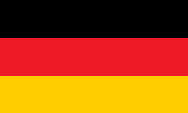

- Tuscany
- also: Florence
- Region of Italy
- own name: Toscana (Firenze)
- former state on the Italian peninsula
- former names: Tuscia, Etruria
- 1531–1569 Duchy of Florence
- 1569–1801 Grand Duchy of Toscana
- 1801–1808 Kingdom of Etruria
- 1814–1860 Grand Duchy of Toscana
- own names: 1.) Ducato di Firenze, 2.) Granducato di Toscana, 3.) Regno di Etruria
• Flags
• Historical Flags
• Meaning/Origin of the Flag
• Coat of Arms
• Meaning/Origin of the Coat of Arms
• Map of the historical states in Italy
• Numbers and Facts
• History
• Origin of the Country's Name
• Map of the today's regions of Italy
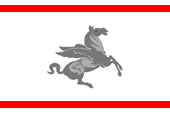
today's flag of the Tuscany,
ratio = 2:3,
Source, by: Wikipedia (D)





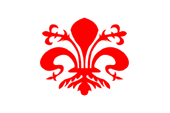
Flag of Florence,
ratio = 2:3,
Source, by: Wikipedia (EN)






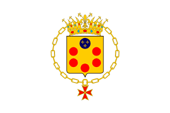
16th cent.,
Flag of the Duchy of Florence,
Source, by: World Statesmen



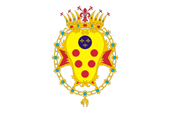
16.-18th cent.,
Flag of the Duchy of Tuscany,
Source, by: Wikipedia (D)



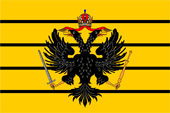
1737– 1765,
Flag of the Duchy of Tuscany,
Source, by: Flags of the World,
World Statesmen




1765–1801,
Flag of Grand Duchy of Tuscany,
Source, by: Flags of the World



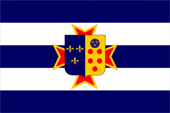
1801–1808,
Flag of the Kingdom of Etruria,
Source, by: Flags of the World



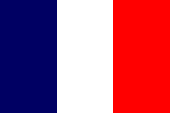
1808–1814,
the Tuscany belongs to France





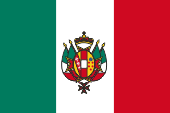
1848–1849,
Flag of Grand Duchy of Tuscany,
Source, by: Flags of the World




1814–1859,
Flag of Grand Duchy of Tuscany,
Source, by: Flags of the World




The current flag of Tuscany is white with two narrow red stripes near the top and bottom of the flag. In the middle appears a silvery Pegasus (winged horse). In the time of Renanaissance when Florence was an important city under the influence of the Medici family, the flags of the city also had been white. The two red stripes may remember the time of Tuscany as an Grand Duchy of the House of Habsburg, as a red-white-red flag was used. The silvery Pegasus goes back to a coin of the Renaissance-artist Benvenuto Cellini in honor of Cardinal Pietro Bembo from 1537.
The original Heraldry from the time of the Medici showed from 1465 a golden shield with five red balls and above a blue disc with three golden lilies. This coat of arms was even used on white flags. After the Medici family extincted in 1737, the Tuscany came to the House of Habsburg, and it was introduced a typical dark yellow flag, which showed four black horizontal stripes, similar to the merchant flag of the Austro-Habsburg Imperium of this this years. In 1765, however, the flag was changed to the for the Austrian Habsburgs typical red-white-red flag, which showed even the coat of arms of the Habsburg Tuscany.
In the years from 1801 to 1808 Napoleón established in the Tuscany the Kingdom of Etruria under the Spanish Bourbons. In this time were used blue and white striped flags with a version of the arms of Tuscany. After the Tuscany was annexed by France between 1808 and 1814, the old red-white-red flag was reintroduced and retained until the end of the duchy in 1859. From 1848 to 1849 raged in almost all of Italy the uprising of the people's movement "Giòvane Itàlia" under Mazzini and Garibaldi, the monarchies were often shortly disempowered, and in this rebellion-phase in the Italian States were often used national-italian flags in green, white and red.
Source: Wikipedia (D),
World Statesmen,
Flags of the World


14th-15th cent.,
Coat of arms of Medici family,
Source, by: www.heraldique.org

from 1465,
Coat of arms of Medici family,
Source, by: www.heraldique.org
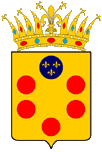
16th-17th cent.,
Coat of arms of the Duchy/Grand Duchy of Tuscany,
Source, by: www.heraldique.org
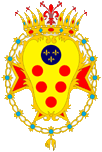
18th cent.,
Coat of arms of the Grand Duchy of Tuscany,
Source, by: Wikipedia (D)

1801–1808,
Coat of arms of the Kingdom of Etruria,,
Source, by: Wikipedia (D)

1814–1859,
Coat of arms of the Grand Duchy of Tuscany,
Source, by: Wikipedia (D)

The coat of arms of the city and the to 1531 existing Florentine Republic showed a red lily on silver. The coat of arms of the Medici family, which became Dukes of Florence in 1531 (Duchy of Tuscany), originally showed six red balls on gold, but the family was allowed to use in the coat of arms – with the approval of the French king in 1465 – a blue disc with three golden lilies. For that one of the red balls was removed and the arrangement on the shield was changed a little bit. The Medici coat of arms became in 1531 the coat of arms of the Duchy of Tuscany, and the heraldry with the five red balls and the blue disc with the lilies appears again and again in the arms of the rulers of Tuscany, from whatever noble house they came.
Source: Wikipedia (D),
World Statesmen,
www.heraldique.org

all state denominations in English
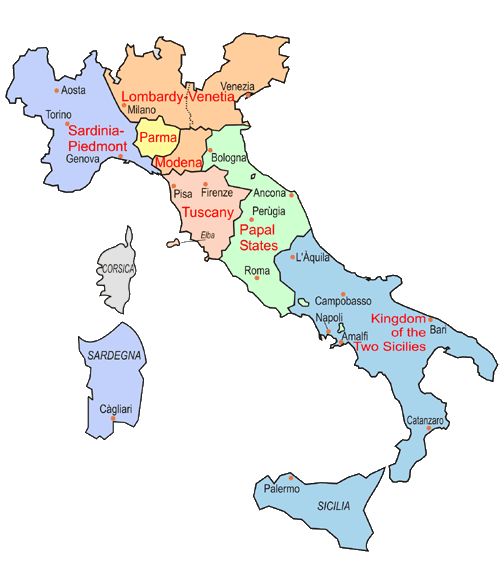
Source: Volker Preuß

Area: 8.876 square miles, (1861: 8.625 sq. mi.)
Inhabitants: 3.750.000 (2016), 1.826.000 (1861)
Density of Population: 422 inh./sq.mi.
Capital: Florence (ital.: Firenze), 382 000 Ew. (2016)
Language: Italian
Time Zone: GMT + 1
Source: Wikipedia (D),
Brockhaus Konversationslexikon

antiquity · settlement by Etruscians, later to the Roman Empire
406 · conquest by the Western Goth
475 · the Tuscany becomes a Margraviate of the Eastern Goth
476 · dismissal of the last Roman emperor Romulus Augustulus, end of the (West)Roman Empire, Tuscany belongs until 493 to the Empire of the Odoaker
535 · conquest by Byzantium (East Roman Empire)
568/569 · conquest of Tuscany by the Langobardes and incorporation into their empire
774 · conquest by the Franks, the Tuscany gets incorporated as Margraviate of Tuscien into the Frankish Empire of the Carolingians
843 · at the division of the Frankish Empire the Tuscany comes to the Kingdom of Italy
961 · the German King Otto I. brings the Tuscany to the German Kingdom
1115 · extinction of the Margrave family of Canossa
12th–13th cent. · distribution of the heritage between the towns of Florence, Siena, Pisa, Lucca and Arezzo
14th–15th cent. · the Republic of Florence gains the predominance in the Tuscany and gets the largest part of the land under it's control ( 1351 acquisition of Prato, 1361 acquisition of Volterra, 1384 acquisition of Arezzo, 1405 acquisition of Pisa, 1441 alliance with Lucca)
16th cent. · rise of the Medici family
1531 · Alessandro de Medici is raised by the German Emperor to the Duke of Florence (Duchy of Florence)
1557 · Florence enlarges it's territory by incorporation of the Republic of Siena
1569 · the Pope raises Florence to a Grand Duchy (Grand Duchy of Tuscany)
1737 · extinction of the Medici
1738 · peace of Vienna, the throne of the Grand Duchy of Tuscany comes as Secundogeniture to the House of Habsburg-Lothringen
1799 · invasion of French revolutionary troops, proclamation of the 'Etruscan Republic' escape of the Grand Duke, popular uprising, expulsion of the French, return of the Grand Duke
1800 · Battle of Marengo, the French return
1801 · Peace of Lunéville, end of the Habsburg rule, Napoleon establishes the Kingdom of Etruria in Tuscany under the Spanish Bourbons; the Grand Duke gets compensated in 1802 with the Duchy of Salzburg, in 1805 with the Grand Duchy of Wuerzburg
1808 · the Kingdom of Etruria gets dissolved and directly united with France
1814 · Vienna Congress, re-establish of the Grand Duchy of Tuscany
1815 · the Tuscany gets enlarged by the Principality of Piombino, Elba Island and by the Stato dei Presidi
1847 · purchase and annexation of Lucca
1859 · the House of Habsburg-Lothringen gets dismissed
1860 · the Tuscany joins the Kingdom of Sardinia-Piedmont (from 1861 Italy)
1948 · establish of the Tuscany region as an administrative unit
Source: Wikipedia (D),
Atlas zur Geschichte,
World Statesmen

The name "Tuscany" goes back to the Romans. They called the Etruscans - who settled in this area as "Tusci". This word may go back to the name "Tyrrhenians", which the Etruscans once gave themselves in honor of their leader "Tyrrhenos".
Source: Handbuch der geographischen Namen

all names in Italian
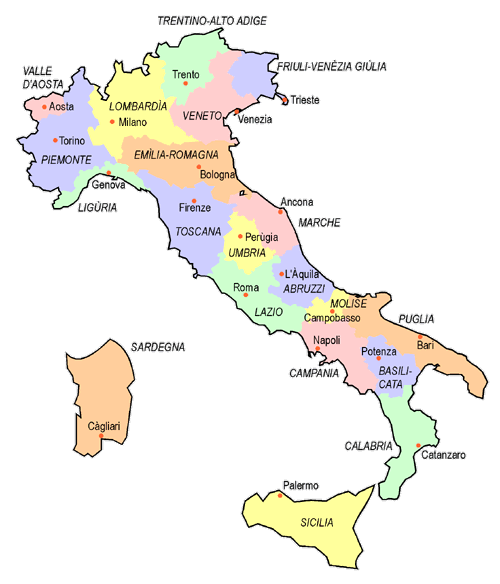
Source: Volker Preuß


Kindly supported by:

![]()










































